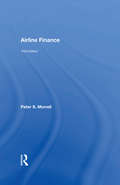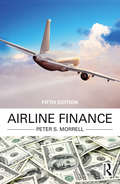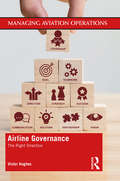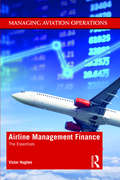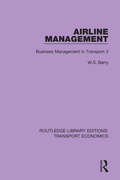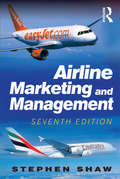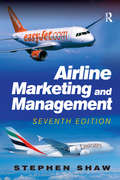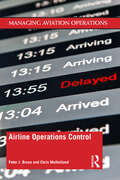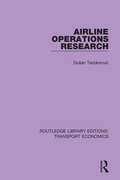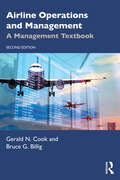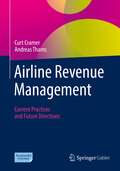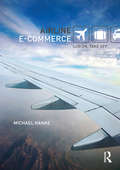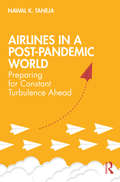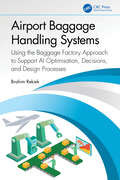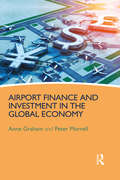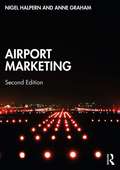- Table View
- List View
Airline Economics: An Empirical Analysis of Market Structure and Competition in the US Airline Industry
by Giovanni Alberto TabaccoThis book presents an original empirical investigation of the market structure of airline city pair markets, shedding new light on the workings of competitive processes between firms. Examining a cross-section of US airline city pairs, Tabacco proposes for the first time that the industry can be understood as a natural oligopoly, each airline market being dominated by one to three airline carriers regardless of market size. The author questions the extent to which airlines deliberately prevent head-to-head competition within city pair markets, and draws intriguing conclusions about competitive forces from the observed market structure. Uncovering some of the main corporate strategies of the airline industry, the book is of immediate relevance to industry managers and practitioners, as well as academic economists.
Airline Finance
by Peter S. MorrellAir transport industry finance, with its complexity and special needs such as route rights, airport slots, aircraft leasing options and frequent flyer programmes, requires specific knowledge. While there are numerous financial management and corporate finance texts available, few of these provide explanations for the singularities of the airline industry with worked examples drawn directly from the industry itself. Revised and updated in its third edition, this internationally renowned and respected book provides the essentials to understanding all areas of airline finance. Designed to address each of the distinct areas of financial management in an air transport industry context, it also shows how these fit together, while each chapter and topic provides a detailed resource which can be also consulted separately. Supported at each stage by practical airline examples, it examines the financial trends and prospects for the airline industry as a whole, contrasting the developments for the major regions and airlines. Important techniques in financial analysis are applied to the airline industry, together with critical discussion of key issues. Thoroughly amended and updated throughout, the third edition reflects the many developments that have affected the industry since 2001. It features several important new topics, including Low Cost Carriers (LCCs), fuel hedging and US Chapter 11 provisions. The sections on financial statements and privatisation have been expanded, and a new chapter has been added on equity finance and IPOs. New case studies have been added, as well as the latest available financial data. The range and perspective is even greater than before, with significant expansion of material specific to the US and Asia. The book is a key resource for students of airline management, and a sophisticated and authoritative guide for analysts in financial institutions and consultancies, executives in airlines and related industries, and civil aviation departments.
Airline Finance
by Peter S. MorrellRevised and updated in its fifth edition, this internationally renowned and respected book provides the essentials to understanding all areas of airline finance. Designed to address each of the distinct areas of financial management in an air transport industry context, it also shows how these fit together, while each chapter and topic – for example, aircraft leasing – provides a detailed resource that can also be consulted separately. Supported at each stage by practical airline examples and recent data, Airline Finance examines the financial trends and longer term prospects for the airline industry as a whole, contrasting the developments for the major regions and airlines together with critical discussion of key issues that affect the industry as a whole. Important techniques in financial analysis are applied to the airlines as well as their investors such as banks and other financial institutions. Thoroughly amended and updated throughout, and expanded with the addition of two new chapters, the fifth edition reflects the many developments that have affected the industry, such as the impacts of the banking and sovereign debt crises on the airline industry, signs of re-nationalisation of airlines that have emerged in Europe, and the substantial changes that have occurred in connection with rating agencies and LIBOR. New start-ups and bankruptcies are covered for the first time in a new chapter, joined by airline mergers and acquisitions (M&A), both playing a role in airline concentration. Reflecting their status as a permanent feature, fuel hedging and fuel surcharges now also have their own chapter. The medium- to long-term future in terms of further concentration and government intervention (or the lack of it) and a shift in aircraft financing towards capital markets are discussed in the final chapter. The book is written for employees of airlines, airports and their suppliers, and investment bank and other analysts. It is also popular for use by universities and in-house courses on air transport management, within both academia and industry.
Airline Finance (Routledge Revivals Ser.)
by Peter S. MorrellAir transport industry finance, with its complexity and special needs such as route rights, airport slots, aircraft leasing options and frequent flyer programmes, requires specific knowledge. While there are numerous financial management and corporate finance texts available, few of these provide explanations for the singularities of the airline industry with worked examples drawn directly from the industry itself. Revised and updated in its fourth edition, this internationally renowned and respected book provides the essentials to understanding all areas of airline finance. Designed to address each of the distinct areas of financial management in an air transport industry context, it also shows how these fit together, while each chapter and topic provides a detailed resource which can be also consulted separately. Supported at each stage by practical airline examples, it examines the financial trends and prospects for the airline industry as a whole, contrasting the developments for the major regions and airlines. Important techniques in financial analysis are applied to the airline industry, together with critical discussion of key issues. Thoroughly amended and updated throughout, the fourth edition reflects the many developments that have affected the industry, with a particular emphasis on the full impact of the global banking and sovereign debt crises. This edition also features new material discussing the increased airline mergers and acquisitions (M&A) activity of recent years, and considers the likelihood of further consolidation in the future. The book is a key resource for students of airline management, and a sophisticated and authoritative guide for analysts in financial institutions and consultancies, executives in airlines and related industries, and civil aviation departments.
Airline Governance: The Right Direction (Managing Aviation Operations)
by Victor HughesAnyone becoming a company director faces a steep learning curve; this book will give every director and especially one joining the board of an airline, a head-start on the process.Airline Governance: The Right Direction will help existing directors, those who have been newly appointed and those ‘in waiting’ in a company’s management. This book reviews the fundamentals of corporate governance and puts them into the context of guiding, directing and managing an airline, and also complements the discussion of accounting and finance in its sister book Airline Management Finance: The Essentials. The detailed review will give directors confidence to make decisions on governance matters, avoiding a ‘tick the box’ approach and focusing on what is important. This book not only gives directors a comprehensive introduction to good governance, but also discusses the application of the principles of governance for an airline at various stages of its development so any changes can be made at the right time.Understanding corporate governance not only helps directors, but also an airline’s senior and junior management, because the considerations around matters such as ‘conflict of interest’ apply to all decision-makers in the organisation. Understanding and applying good governance does not guarantee success, but it surely helps in achieving it.
Airline Industry: Poised for Disruptive Innovation?
by Nawal K. TanejaMany business sectors have been, and are being, forced to compete with new competitors-disrupters of some sort-who have found new ways to create and deliver new value for customers often through the use of technology that is coupled with a new underlying production or business model, and/or a broad array of partners, including, in some cases, customers themselves. Think about the disruption created by Apple by the introduction of the iPod and iTunes, and by Netflix within the entertainment sectors using partners within the ecosystem; think of Uber that didn’t build an app around the taxi business but rather built a mobility business around the app to improve customer experience. Airline Industry considers whether the airline industry is poised for disruptive innovations from inside or outside of the industry. Although airlines have a long history of continuous improvements and innovation, few of their innovations can be classified as disruptive innovations. The few disruptive innovations that did emerge were facilitated, for example by new technology (jet aircraft) and government policy (deregulation). Now there are new forces in play-customers who expect to receive products that are more personalized and experience-based throughout the entire journey, new customer interfaces (via social media), advanced information systems and analytics, financially powerful airlines based in emerging nations, and the rise of unencumbered entrepreneurs who think differently as well as platform-focused integrators.
Airline Management Finance: The Essentials (Managing Aviation Operations)
by Victor HughesAirline Management Finance: The Essentials is of significant benefit to airline industry practitioners seeking a focused, neatly contained and accessible resource that provides explicit financial information pertinent to their current or future role. The book explains and demystifies an airline’s financing and the financial reporting of its operations to airline staff and others. It seeks to explain the role of finance and the Finance Department in a non-technical way, so staff can appreciate the value of the department and its information resources, and see finance as an active contributor to the airline’s operation. It concentrates on practical matters, explaining frequently used financial and accounting terms, how financial strategy works, the uses of various types of financial reporting, as well as what financial risk is and how it can be managed through the co-operation of finance and operating staff. Staff who understand the airline’s finances and financial system are more likely to make decisions which align with the airline’s strategy and objectives. They will also know how to use the financial information which is available. The book establishes a good foundation of financial knowledge for all staff. This book is recommended reading for new employees in airline finance and related areas, as well as those starting to move up the supervisory ladder in an airline.
Airline Management: Business Management in Transport 3 (Routledge Library Editions: Transport Economics #2)
by W.S. BarryThis book, first published in 1965, illustrates the world of management in the airline industry. It examines the external relations with customers, government, investors, suppliers and competitors, as well as internal relations within the business such as organization and industrial relations.
Airline Marketing and Management
by Stephen ShawThrough six previous editions, Airline Marketing and Management has established itself as the leading textbook for students of marketing and its application to today's airline industry, as well as a reference work for those with a professional interest in the area. Carefully revised, the seventh edition of this internationally successful book examines an exceptionally turbulent period for the industry. It features new material on: *Changes in customer needs, particularly regarding more business travellers choosing - or being forced - to travel economy, and analysis of the bankruptcy of 'All Business Class' airlines. * An explanation of the US/EU 'Open Skies' agreement and analysis of its impact. *The increase in alliance activity and completion of several recent mergers, and the marketing advantages and disadvantages that have resulted. * Product adjustments that airlines must make to adapt to changes in the marketing environment, such as schedule re-adjustments and the reconfiguration of aircraft cabins. *Changes in pricing philosophies, with, for example, airlines moving to 'A La Carte' pricing, whereby baggage, catering and priority boarding are paid for as extras. *Airline websites and their role as both a selling and distributing tool. *The future of airline marketing. A review of the structure of the air transport market and the marketing environment is followed by detailed chapters examining business and marketing strategies, product design and management, pricing and revenue management, current and future distribution channels, and selling, advertising and promotional policies. The reader will benefit from greater understanding of both marketing and airline industry jargon and from knowledge obtained regarding the extraordinary strategic challenges now facing aviation. Written in a straightforward, easy-to-read style and combining up-to-date and relevant examples drawn from the worldwide aviation industry, this new edition will further enhance the book's reputation for providing the ideal introduction to the subject.
Airline Marketing and Management
by Stephen ShawThrough six previous editions, Airline Marketing and Management has established itself as the leading textbook for students of marketing and its application to today's airline industry, as well as a reference work for those with a professional interest in the area. Carefully revised, the seventh edition of this internationally successful book examines an exceptionally turbulent period for the industry. It features new material on: *Changes in customer needs, particularly regarding more business travellers choosing - or being forced - to travel economy, and analysis of the bankruptcy of 'All Business Class' airlines. * An explanation of the US/EU 'Open Skies' agreement and analysis of its impact. *The increase in alliance activity and completion of several recent mergers, and the marketing advantages and disadvantages that have resulted. * Product adjustments that airlines must make to adapt to changes in the marketing environment, such as schedule re-adjustments and the reconfiguration of aircraft cabins. *Changes in pricing philosophies, with, for example, airlines moving to 'A La Carte' pricing, whereby baggage, catering and priority boarding are paid for as extras. *Airline websites and their role as both a selling and distributing tool. *The future of airline marketing. A review of the structure of the air transport market and the marketing environment is followed by detailed chapters examining business and marketing strategies, product design and management, pricing and revenue management, current and future distribution channels, and selling, advertising and promotional policies. The reader will benefit from greater understanding of both marketing and airline industry jargon and from knowledge obtained regarding the extraordinary strategic challenges now facing aviation. Written in a straightforward, easy-to-read style and combining up-to-date and relevant examples drawn from the worldwide aviation industry, this new edition will further enhance the book's reputation for providing the ideal introduction to the subject.
Airline Marketing and Management
by Stephen ShawThrough six previous editions, Airline Marketing and Management has established itself as the leading textbook for students of marketing and its application to today's airline industry, as well as a reference work for those with a professional interest in the area. Carefully revised, the seventh edition of this internationally successful book examines an exceptionally turbulent period for the industry. It features new material on: *Changes in customer needs, particularly regarding more business travellers choosing - or being forced - to travel economy, and analysis of the bankruptcy of 'All Business Class' airlines. * An explanation of the US/EU 'Open Skies' agreement and analysis of its impact. *The increase in alliance activity and completion of several recent mergers, and the marketing advantages and disadvantages that have resulted. * Product adjustments that airlines must make to adapt to changes in the marketing environment, such as schedule re-adjustments and the reconfiguration of aircraft cabins. *Changes in pricing philosophies, with, for example, airlines moving to 'A La Carte' pricing, whereby baggage, catering and priority boarding are paid for as extras. *Airline websites and their role as both a selling and distributing tool. *The future of airline marketing. A review of the structure of the air transport market and the marketing environment is followed by detailed chapters examining business and marketing strategies, product design and management, pricing and revenue management, current and future distribution channels, and selling, advertising and promotional policies. The reader will benefit from greater understanding of both marketing and airline industry jargon and from knowledge obtained regarding the extraordinary strategic challenges now facing aviation. Written in a straightforward, easy-to-read style and combining up-to-date and relevant examples drawn from the worldwide aviation industry, this new edition will further enhance the book's reputation for providing the ideal introduction to the subject.
Airline Network Development in Europe and its Implications for Airport Planning
by Guillaume BurghouwtThe ongoing deregulation and liberalization of worldwide air transport markets confronts airport planners with an increasingly problematic context. On the one hand, the capital intensive, large-scale and complex airport investments need a detailed, long/medium-term planning of airport infrastructure. Such planning requires at least predictable traffic volumes (and traffic composition) within the planning horizon. On the other hand, airline route networks are increasingly dynamic structures that frequently show discontinuous changes. As a consequence, the much more volatile airport traffic restricts the value of detailed traffic forecasts. Volatility of airport traffic and its composition requires flexibility of airport strategies and planning processes. The book explores this dilemma through a detailed study of airline network development, airport connectivity and airport planning in the deregulated EU air transport market. The questions the book seeks to answer are: · how have airlines responded to the regime changes in EU aviation with respect to the configuration of their route networks? · what has been the impact of the reconfiguration of airline network configurations for the connectivity of EU airports? · how can airport planners and airport authorities deal with the increasingly uncertain airline network behaviour in Europe?
Airline Network Planning and Scheduling (Wiley Series in Operations Research and Management Science)
by Ahmed Abdelghany Khaled AbdelghanyA concise resource to the best practices and problem-solving ideas for understanding the airline network planning and scheduling process Airline Network Planning and Scheduling offers a comprehensive resource that is filled with the industry's best practices that can help to inform decision-modeling and the problem-solving process. Written by two industry experts, the book is designed to be an accessible guide that contains information for addressing complex challenges, problems, and approaches that arise on the job. The chapters begin by addressing the complex topics at a broad, conceptual level before moving on to more detailed modeling in later chapters. This approach follows the standard airline planning process and reflects the duties of the day-to-day job of network/schedule planners. To help gain a practical understanding of the information presented, each chapter includes exercises and data based on real-world case studies. In addition, throughout the book there are graphs and illustrations as well as, information on the most recent advances in airline network and planning research. This important resource: • Takes a practical approach when detailing airline network planning and scheduling practices as opposed to a theoretical perspective • Puts the focus on the complexity and main challenges as well as current practices and approaches to problem-solving and decision-making • Presents the information in a logical sequence that begins with broad, conceptual topics and gradually delves into more advanced topics that address modeling • Contains international standard airline planning processes, the day-to-day responsibilities of the job, and outlines the steps taken when building an airline network and schedule • Includes numerous case studies, exercises, graphs, and illustrations throughout Written for professionals and academics, Airline Network Planning and Scheduling offers a resource for understanding best practices and models as well as the challenges involved with network planning and scheduling.
Airline Operations Control (Managing Aviation Operations)
by Peter J. Bruce Chris MulhollandThis text is among the first to reveal the intricacies of an airline’s Operations Control Centre; especially the thought processes, information flows, and strategies taken to mitigate disruptions. Airline Operations Control provides a deep level of description, explanation and detail into the activities of a range of highly professional and expert staff managing the ‘sharp’ end of the airline. It aims to fill a void as little is understood about this area, and very little is written for practitioners in the airline business. The book offers a comprehensive look at the make-up of the Operations Centre, its component sections, and the processes that occur both in preparing for and executing the current day’s schedules. Several chapters provide real-life scenarios and demonstrate how Operations Centres manage evolving situations – what they need to take into account, and how they need to have Plan B and Plan C ready when things don’t go right. This book is designed to deliver knowledge gains to both new and experienced aviation industry practitioners with regards to vital operational aspects. Additionally, it also offers students of air transport management a readily accessible and real-world-perspective guide to a crucial function present within every airline.
Airline Operations Research (Routledge Library Editions: Transport Economics #3)
by Dusan TeodorovicThe increase in practical problems generated by the intensive growth in air transport has necessitated the development of specialised operations research methods and modern computer technology. By combining operational research data from both scientific publications and airline companies, this book, first published in 1988, provides a unique source of information for those working on the development and application of operations research analysis in air transportation. Topics include air transport analysis, flight frequency determination, the scheduling of flights and personnel, and the problems of airline overbooking.
Airline Operations and Management: A Management Textbook
by Bruce Billig Gerald N. CookAirline Operations and Management: A Management Textbook presents a survey of the airline industry, with a strong managerial perspective. It integrates and applies the fundamentals of several management disciplines, particularly operations, marketing, economics and finance, to develop a comprehensive overview. It also provides readers with a solid historical background, and offers a global perspective of the industry, with examples drawn from airlines around the world. Updates for the second edition include: • Fresh data and examples • A range of international case studies exploring real-life applications. • New or increased coverage of key topics such as the COVID-19 pandemic, state aid, and new business models. • New chapters on fleet management and labor relations and HRM. • Lecture slides for instructors. This textbook is for advanced undergraduate and graduate students of airline management, but it should also be useful to entry and junior-level airline managers and professionals seeking to expand their knowledge of the industry beyond their functional area.
Airline Operations: A Practical Guide
by Peter J. Bruce Yi Gao John M. KingWritten by a range of international industry practitioners, this book offers a comprehensive overview of the essence and nature of airline operations in terms of an operational and regulatory framework, the myriad of planning activities leading up to the current day, and the nature of intense activity that typifies both normal and disrupted airline operations. The first part outlines the importance of the regulatory framework underpinning airline operations, exploring how airlines structure themselves in terms of network and business model. The second part draws attention to the operational environment, explaining the framework of the air traffic system and processes instigated by operational departments within airlines. The third part presents a comprehensive breakdown of the activities that occur on the actual operating day. The fourth part provides an eye-opener into events that typically go wrong on the operating day and then the means by which airlines try to mitigate these problems. Finally, a glimpse is provided of future systems, processes, and technologies likely to be significant in airline operations. Airline Operations: A Practical Guide offers valuable knowledge to industry and academia alike by providing readers with a well-informed and interesting dialogue on critical functions that occur every day within airlines.
Airline Revenue Management: Current Practices and Future Directions
by Curt Cramer Andreas ThamsThe book provides a comprehensive overview of current practices and future directions in airline revenue management. It explains state-of-the-art revenue management approaches and outlines how these will be augmented and enhanced through modern data science and machine learning methods in the future. Several practical examples and applications will make the reader familiar with the relevance of the corresponding ideas and concepts for an airline commercial organization. The book is ideal for both students in the field of airline and tourism management as well as for practitioners and industry experts seeking to refresh their knowledge about current and future revenue management approaches, as well as to get an introductory understanding of data science and machine learning methods. Each chapter closes with a checkpoint, allowing the reader to deepen the understanding of the contents covered.This textbook has been recommended and developed for university courses in Germany, Austria and Switzerland.
Airline e-Commerce: Log on. Take off.
by Michael HankeFrom the few tickets that were sold by Alaska Airlines and former British Midland in December 1995 via the industry’s first airline booking engine websites, global online travel has grown to generate today more than half a trillion dollars in annual revenue. This development has brought significant changes to the airline business, travel markets, and consumers. Today, airlines worldwide not only use e-commerce for online marketing and selling but also as a platform to offer unique services and capabilities that have no counterpart in the physical world. This book is an in-depth introduction to airline e-commerce. It covers a broad scope of areas that are essential to an airline’s ongoing digital transformation. Digital properties & features E-marketing E-sales & distribution Web customer service E-commerce organization E-commerce strategy Written by an airline e-commerce expert and illustrated with numerous examples of leading airlines in this area, Dr. Hanke provides for comprehensive "behind-the-scenes" details of how airline e-commerce works. This book is a crucial companion for students and practitioners alike because it allows the reader to acquire a thorough foundation of airline e-commerce. Furthermore, the book enables the reader to appreciate the ramifications of airline e-commerce in certain corporate areas and to take effective action for a successful e-commerce strategy.
Airlines in a Post-Pandemic World: Preparing for Constant Turbulence Ahead
by Nawal K. TanejaThe COVID-19 pandemic represents an extraordinary inflection point that caught airlines worldwide unprepared, causing CEOs to recalibrate their business models. This book explains why this unprecedented pandemic is different from the past disruptions experienced by the airline industry during the past 50 years, and what airlines and related businesses now can do to adapt to the dramatically changed marketplace. This book presents two future scenarios: continuous improvements and elastic supply. These are considered in three specific contexts for the rebuilding of the airline business. These contexts, in the order of urgency with respect to change from the status quo, are the following. The first context is for airlines to become better prepared to deal with frequent and deeper disruptions that could be localized or globalized relating to such areas as climate change, geopolitics, and cybersecurity. The second context is to collaborate and integrate within the much broader travel ecosystem, possibly using platforms to innovate on new value systems. The third context, which has always been the case and drives the first two, is for airlines to offer real solutions to people’s travel needs, solutions developed with imagination and turbocharged innovation, even as we contemplate new technology airplanes and mobility as a service solutions. This book is recommended reading for all senior-level practitioners of airlines and related businesses, as well as aviation policy makers worldwide.
Airport Baggage Handling Systems: Using the Baggage Factory Approach to Support AI Optimisation, Decisions, and Design Processes
by Brahim RekiekThe competition between airports demands higher-quality services to satisfy passengers. A Baggage Handling System (BHS) serves functions such as baggage sorting, screening, and storage. A successful BHS means bags move between areas as travellers do. Handlers load/unload bags and transfer them between the airport's areas. Automation can save money and bring safety and operational benefits. Warehouses as well as the automotive industry are more advanced technologically in comparison to the airport and especially the baggage handling business. The concept of the Baggage Factory (BF) is an approach (based on Industry 4.0) that simplifies the processes from the moment passengers drop off their bags at check-in till the destination (chutes, carousels, and so forth). Airport Baggage Handling Systems: Using the Baggage Factory Approach to Support AI Optimisation, Decisions, and Design Processes introduces the features of the BF concept and presents how BHS designers can use AI technology to tackle many BHS problems and concerns. The book bridges the gap between airport BHS designers and experts in AI and optimisation. It describes in detail the field of baggage handling using algorithms for sorting bags or optimising the flow. The way the systems are designed is discussed, and a behind-the-scenes look at the BHS industry and how it affects the daily lives of travellers is presented. International and multidisciplinary in approach, this book is an ideal resource for practitioners, students, and researchers involved in the air transportation industry, Tourism, Systems Engineering, Layout and Design, Artificial Intelligence, Assembly Automation, and Logistics fields.
Airport Building Information Modelling
by Yusuf Arayici Ozan KoseogluThis book details how Building Information Modelling is being successfully deployed in the planning, design, construction and future operation of the Istanbul New Airport, a mega-scale construction project incorporating a varying mix of infrastructures including terminals, runways, passenger gates, car parks, railways and roads. The book demonstrates how Airport Building Information Modelling (ABIM) is being used to: • facilitate collaboration, cooperation and integrated project delivery • manage subcontractors and eliminate cost over-runs • reduce waste on site and enhance overall quality • connect people in a virtual environment to encourage collaborative working • provide clients with an effective interface for lifecycle management including: design development, construction documentation, construction phases and BIM and Big Data Integration for future facilities management The book presents a best practice BIM project, demonstrating concurrent engineering, lean processes, collaborative design and construction, and effective construction management. Moreover, the book provides a visionary exemplar for the further use of BIM technologies in civil engineering projects including highways, railways and others on the way towards the Smart City vision. It is essential reading for all Built Environment and Engineering stakeholders.
Airport Economics: Recent Developments In Australasia, North America And Europe (Managing Aviation Operations)
by Peter Forsyth Hans-Martin Niemeier Cathal GuiomardThis book provides a comprehensive guide to the economics of airports for all managers, regulators and educators within the aviation industry. Written by three renowned experts but made accessible and relevant for all those working within the industry, or aspiring to do so, it is the perfect entry point for learning about the underlying economics of airports as a crucial component of the air transport system. It explains the cost structures of airports and then relates these to how airports determine their charges. It explains how charges at different airports vary, whether this is due to different types of traffic, different input prices, ways of producing outputs or different levels of efficiency. Most airports are publicly owned or regulated, and there has been a trend towards privatisation. The book explains how airports have been regulated and assesses how well the regulatory structures have performed; it discusses the trend towards light-handed regulation and the reliance on competition where this exists. The book examines the problems of limited capacity at airports and how these are resolved through slots and charging systems, and the long-term solution of investment in airports—why it is controversial, and how it can be achieved effectively. It also considers the environmental impacts of airports and the issues these pose for managers, from the well-known problems of airport noise to the growing recognition of the impacts of air transport on climate change, and the roles airports play in mitigating these consequences. Written for airport and airline managers, regulators and students, this book will suit Bachelor’s and Master’s programmes on air transport management.
Airport Finance and Investment in the Global Economy
by Anne Graham Peter MorrellWhile there are a multitude of publications on corporate finance and financial management, only a few address the complexity of air transport industry finance and scant attention has been given to airport financial management. This book deals exclusively with airport issues to rectify this. It does this with an analysis of the theoretical concepts relevant to the subject area combined with a detailed investigation of current practice within the industry. Airport Finance and Investment in the Global Economy bridges the gap between much academic research on airports published in recent years – lacking much managerial relevance – and real-world airport financial management. This is achieved by featuring expert analysis of contemporary issues specific to airport finance and funding strategies, illustrated by worked examples from a wide range of different countries to enhance understanding and create a global perspective. The book is designed to appeal to both practitioners and academics. Airport-specific topics include: performance measurement and benchmarking, valuation, tools for financial control and management, alternatives of financing, privatisation, competition and implications of economic regulation.
Airport Marketing
by Anne Graham Nigel HalpernThis accessible, up-to-date, comprehensive, and in-depth textbook introduces students and practitioners to the principles and practice of airport marketing as well as the major changes and future marketing challenges facing the airport sector. It applies principles of marketing within the airport industry, and examines airport marketing and its environment, how to define and measure the market for airport services, airport strategic marketing planning and individual elements of the airport marketing mix (product, price, distribution and promotion). The book integrates key elements of marketing theory with airport marketing in practice. Each chapter contains extensive industry examples for different types of airports from around the world to build on the theoretical base of the subject and show real-life applications. This new second edition has been updated to include: New and expanded content on branding and the passenger experience, marketing partnerships, engagement marketing and customer relationship management. Three brand new chapters on digital marketing, marketing for a more sustainable future, and crisis communications and marketing, in light of the Covid-19 pandemic. New, global case studies and examples throughout. This comprehensive textbook written by two airport marketing experts will be essential reading for air transport students and future managers.

